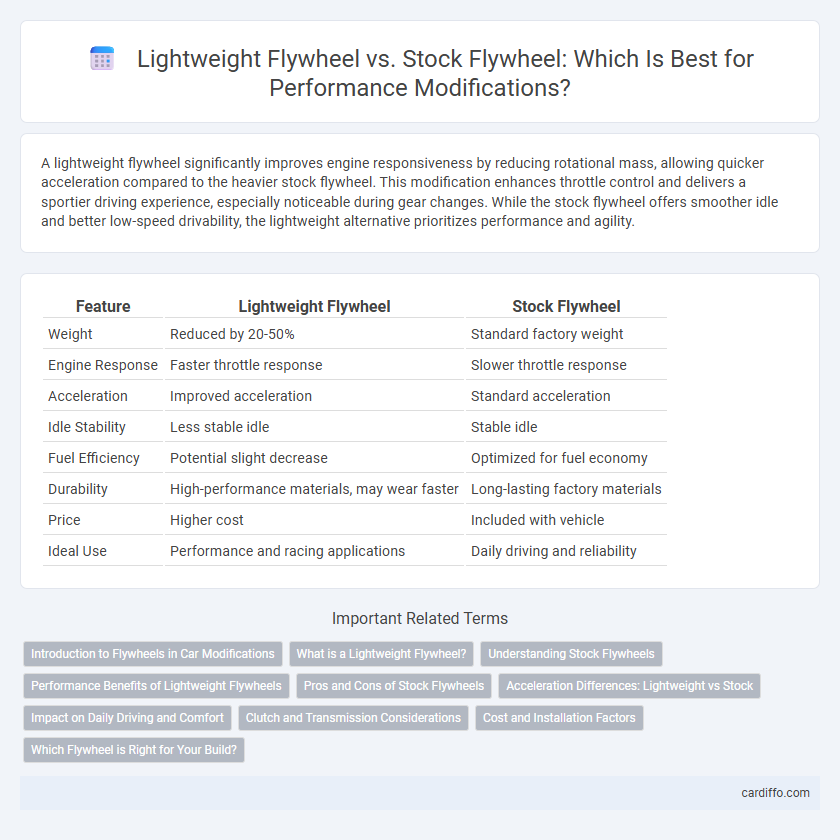A lightweight flywheel significantly improves engine responsiveness by reducing rotational mass, allowing quicker acceleration compared to the heavier stock flywheel. This modification enhances throttle control and delivers a sportier driving experience, especially noticeable during gear changes. While the stock flywheel offers smoother idle and better low-speed drivability, the lightweight alternative prioritizes performance and agility.
Table of Comparison
| Feature | Lightweight Flywheel | Stock Flywheel |
|---|---|---|
| Weight | Reduced by 20-50% | Standard factory weight |
| Engine Response | Faster throttle response | Slower throttle response |
| Acceleration | Improved acceleration | Standard acceleration |
| Idle Stability | Less stable idle | Stable idle |
| Fuel Efficiency | Potential slight decrease | Optimized for fuel economy |
| Durability | High-performance materials, may wear faster | Long-lasting factory materials |
| Price | Higher cost | Included with vehicle |
| Ideal Use | Performance and racing applications | Daily driving and reliability |
Introduction to Flywheels in Car Modifications
Flywheels in car modifications play a crucial role in engine performance by storing rotational energy and smoothing out power delivery. A lightweight flywheel reduces rotational mass, allowing the engine to rev faster and improve throttle response compared to a stock flywheel. This modification enhances acceleration and overall driving dynamics, especially in high-performance or race-oriented vehicles.
What is a Lightweight Flywheel?
A lightweight flywheel is a modified automotive component designed to reduce rotational mass, improving engine response and acceleration. Compared to a stock flywheel, it spins at higher RPMs with less inertia, allowing quicker engine rev changes. This upgrade enhances throttle sensitivity and overall vehicle performance, especially in high-performance and racing applications.
Understanding Stock Flywheels
Stock flywheels are typically heavier than lightweight flywheels, providing greater rotational inertia that stabilizes engine performance and smooths power delivery. The increased mass of stock flywheels allows for easier driving at low RPMs by reducing engine stalling and vibration. Understanding the balance between flywheel weight and engine responsiveness is crucial when considering modifications to optimize acceleration or drivability.
Performance Benefits of Lightweight Flywheels
Lightweight flywheels improve engine response by reducing rotational mass, allowing faster acceleration and deceleration compared to stock flywheels. Enhanced throttle responsiveness and smoother gear shifts contribute to better overall driving dynamics. This performance upgrade also frees up horsepower by decreasing the load on the crankshaft during engine operation.
Pros and Cons of Stock Flywheels
Stock flywheels offer advantages such as reliable durability and smoother engine idling due to their higher rotational inertia, making them ideal for daily driving and maintaining factory settings. However, they tend to be heavier, resulting in slower engine response and reduced acceleration compared to lightweight flywheels. The increased mass of stock flywheels can also contribute to lower fuel efficiency and less agile handling in performance driving scenarios.
Acceleration Differences: Lightweight vs Stock
Lightweight flywheels reduce rotational mass, allowing the engine to rev faster and improve throttle response, which results in quicker acceleration compared to stock flywheels. Stock flywheels have greater inertia, leading to smoother power delivery but slower engine revving and less immediate acceleration. This difference in mass directly influences the vehicle's acceleration performance, making lightweight flywheels ideal for sportier, more responsive driving dynamics.
Impact on Daily Driving and Comfort
A lightweight flywheel reduces rotational mass, resulting in quicker engine response and smoother acceleration, which enhances the overall driving experience in daily commutes. However, it may cause increased vibration and noise, potentially impacting cabin comfort and making gear changes feel less smooth compared to a stock flywheel. Stock flywheels offer better dampening of engine vibrations, providing a quieter, more comfortable ride suited for regular street use.
Clutch and Transmission Considerations
Lightweight flywheels reduce rotational mass, allowing the clutch to engage more quickly and improving throttle response, though they may increase wear on the clutch components due to higher RPM fluctuations. Stock flywheels provide smoother clutch engagement and greater rotational inertia, which helps stabilize the drivetrain and reduce transmission shock. When choosing between them, consider the balance between performance enhancement and the potential for accelerated clutch and transmission wear.
Cost and Installation Factors
Lightweight flywheels typically cost between $300 and $600, which is higher than stock flywheels priced around $100 to $250. Installation of a lightweight flywheel often requires professional expertise due to precise torque specifications and balancing, whereas stock flywheels are easier to install with basic mechanical skills. Budget-conscious modifiers may prefer stock flywheels for lower upfront costs and simpler installation, while performance enthusiasts value lightweight flywheels for improved engine response despite higher expenses.
Which Flywheel is Right for Your Build?
Lightweight flywheels significantly reduce rotational inertia, allowing quicker engine revving and improved throttle response compared to stock flywheels, which offer smoother idling and better drivability for daily use. Selecting the right flywheel depends on your build's purpose: lightweight flywheels excel in performance and track applications, while stock flywheels maintain stability and comfort for street driving. Consider engine characteristics, driving style, and intended use to optimize power delivery and overall vehicle performance.
Lightweight flywheel vs Stock flywheel Infographic

 cardiffo.com
cardiffo.com